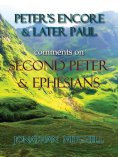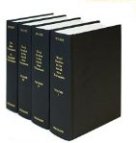
From Introduction:
Both of the NT letters discussed in this book have had their authorship questioned by ancient commentators and by recent scholars. At the same time, other ancient and other current scholars accept the authorship as indicated in the texts. The textual and literary reasons for the doubt by some are reasonable and honest, but so are the reasons for acceptance by others. But what should this mean to the average person who may wish to understand what these ancient documents said, and meant? This book will not address the issue of authorship, but will simply take the documents as we find them, and will also compare what the authors have said with both other NT writings and OT references.
Questions of acceptance into the institutional church’s canon of Scriptures was made during a period of history when the organizational “title,” or considered “office,” of an author (within the church’s early history) was a deciding factor, rather than simply taking the words and thoughts on their own perceived merits, or the spirit that the reader found within the texts, as the “deciding factor” on whether or not the documents should be considered “inspired.” Should it matter whether Peter actually wrote what tradition has labeled as 2 Peter, or whether it was Paul – or one of his students – that wrote Ephesians? The beauty of both truth and admonitions are the same, regardless who it was that originally penned the contents. For a good overview of the reasons that folks think that 2 Peter was written after Peter’s death, William Barclay sets them forth clearly and concisely in, The Letters of James and Peter, The Daily Study Bible Series, Rev. Ed., The Westminster Press, 1976, pp 284-89. The author of this present work receives the arguments of John A.T. Robinson who dates it in the mid-60’s, AD (see comments below). For cogent arguments for Paul as the author of Ephesians, see Ben Witherington III, The Letters to Philemon, the Colossians, and the Ephesians, A Socio-Rhetorical Commentary on the Captivity Epistles, pp 223-4, cited below.
The richness of insights and revelations concerning the results and effects of the Christ-Event and the giving of the Holy Spirit (the Sacred Breath-effect) that are contained in Peter’s reminders and admonitions, and in Paul’s unveilings and encouragements (the “indicatives” and the “imperatives”) are indeed treasures for the followers of Christ, and for the world’s cultures and societies at large. Paul’s sermon and Peter’s letter give beautiful pictures of what God’s reign looks-like, of the realities of our life in Christ in the called-out covenant communities, and of humanity’s positive destiny and expectations.
Following the comments on 2 Peter are three articles that address topics in two of Peter’s sermons in the book of Acts. Following the comments on Ephesians are a short study on a statement by Paul in 1 Cor. 15, a consideration of the topic referred to as “spiritual warfare,” in contemporary Christianity, an investigation into what Paul meant when he used the word, “anathema,” my expanded translation of Psalm 23, from the Septuagint (LXX), for a meditation, a study into the meaning of the phrase, “the kingdom of God,” as it is used in the NT, and finally, a review of the places where Jesus warned of the judgment of “hell.”
May these fresh, expanded translations and the comments that are on offer be an aid to “building the house of the Lord,” Christ’s body.
May all of His goodness overwhelm you,
Jonathan Mitchell













